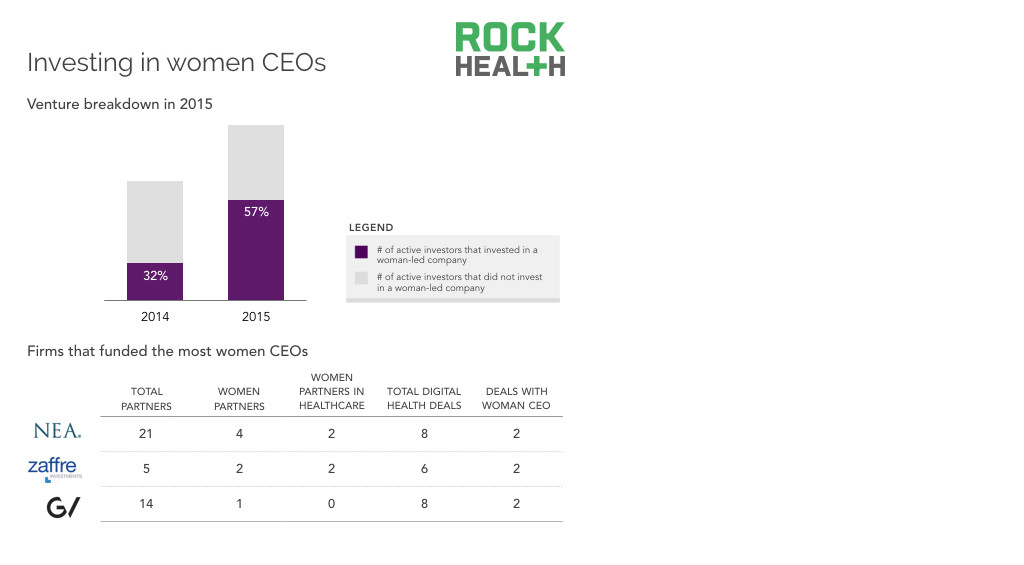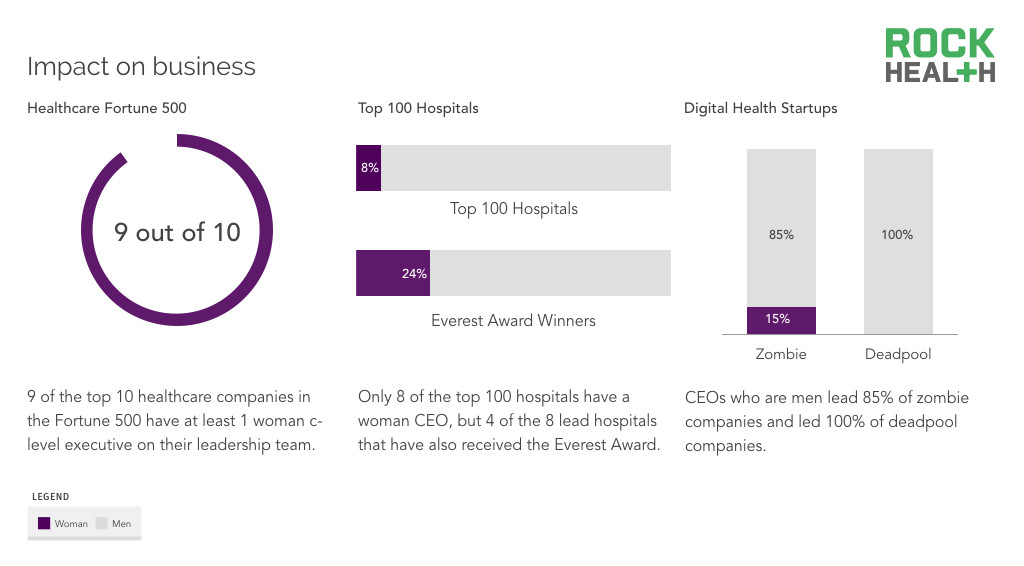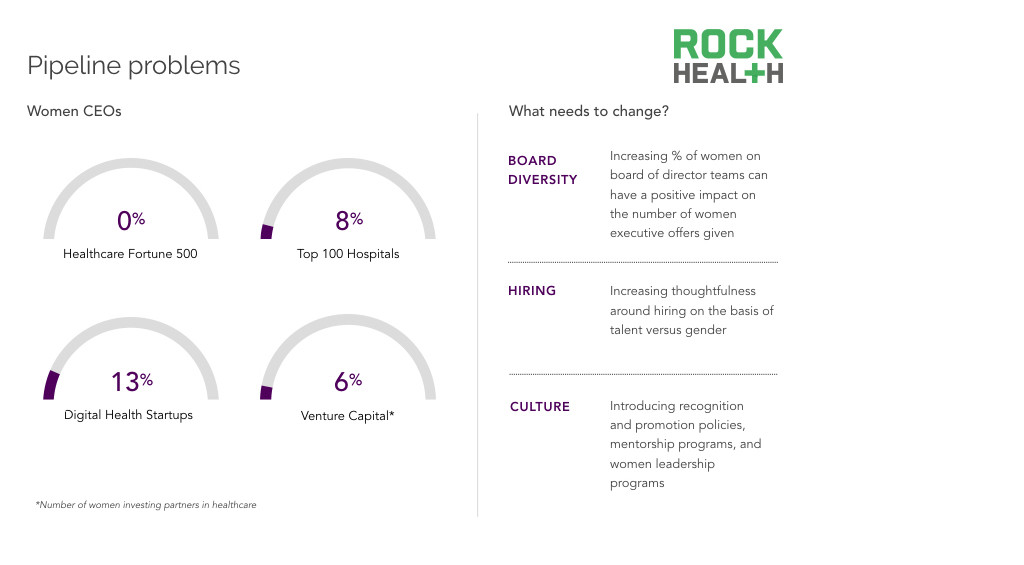The state of healthcare gender diversity 2016
In early 2015, Rock Health released a report that reflected on the state of women in leadership positions within the healthcare industry. Though women play a primary role in making healthcare decisions for their families and 78% of the healthcare workforce is comprised of women, there is still an underrepresentation of women in leadership roles. The report also outlined common disparities that women face when it comes to opportunities related to salary, parenting, career development, and mentorship.
There has been no drastic change in regard to the degree of gender balance across companies, startups, and VC firms focused on healthcare. However, rather than just focusing on the discouragingly low number of women that are represented on these leadership teams, our data shows that having women leaders and a strong gender diverse team has a clear positive impact on business.
This research post reports on why gender diverse teams are good for business, acknowledges the continued uphill battle, and explores the conversations around gender diversity.
Having women on your leadership team is good for business.
Over the years, many academic studies have sourced that gender diversity improves company performance and growth. There is a parallel trend in our own research when analyzing the team makeup of corporate, hospital, startup and investment teams. In our latest State of Gender Diversity in Healthcare survey of 38 women and 12 men, 95% of women agreed that gender diversity has a positive impact on company performance and 58% of men agreed with that statement as well. Below are examples of how gender diverse teams have led to improved recognition, performance, and scalability.
Nine of the top 10 healthcare Fortune 500 companies have women in c-level roles.
In 2015, there were 45 healthcare companies on the Fortune 500 list, and 11% have either a woman CTO or CIO. The amount of companies that have executive teams made up of at least 25% women has dropped slightly by 6% since 2014, but still represents a 50% increase since 2013.
When looking at the top 10 healthcare companies in the 2015 Fortune 500 list, 7 companies have at least 25% of their board made up of women leaders. 9 out of the 10 companies also have women holding c-level roles across the departments of technology, information, human resources, marketing, communications and legal. McKesson, Cardinal Health and AmeriSourceBergen are examples of firms that have gender diverse boards with an average of 30% women, and more than one woman executive on their leadership team.
Gender diversity impacts hospital performance and long-term improvement.
The status of gender diversity in the 2015 Top 100 Hospitals is the strongest relative to healthcare Fortune 500 companies, digital health startups, and venture capital firms. Women make up on average 36% of the executive leadership in the hospitals. In addition to being recognized as a Top 100 Hospital, 17 hospitals were honored with the Everest Award for achieving the highest current performance and fastest long-term improvement over 5 years. Although only 8 of the top 100 hospitals have a woman CEO, 4 of the 8 lead hospitals that also received the Everest Award.
Fewer women CEOs lead zombie startups and none led deadpool startups.
37% of the 56 digital health zombie companies, which we define as companies that have not raised more than $2M since 2012, do not have a single woman on their executive team. Only 15% of the zombie companies are led by women CEOs. All deadpool digital health startups, which are companies that shut down this past year, were led by CEOs who are men.
State of Women in Digital Health

Source: Rock Health Digital Funding Database; Diana Report; Company websites
2015 saw growth in women founded and funded startups.
Compared to 2014, 2015 was a better year for women CEOs in digital health. Our latest funding report discovered that while men still make up the majority of funded digital health CEOs, women led 29 companies funded in 2015, twice the amount than in 2014. Of the companies founded and funded in 2015, 31% had a woman CEO. Average deal size in 2015 was $13.9M for companies led by CEOs who are men and $12.1M for companies led by women CEOs, with notable deals such as 23andMe’s Series E and ClassPass’ Series B and Series C pulling up the average.
Of the 61 acquired companies that have received $2M or more in funding since 2011, 11% of companies were led by women CEOs. Education was not a differentiator as 71% and 69% of women CEOs and CEOs who are men, respectively, had an advanced degree (e.g., MBA, MD, PhD).
Of the 28 most active investors (those with 4 or more deals), 16 of them invested in a company with a woman CEO, representing an increase of 25% since 2014. Google Ventures, NEA, and Zaffre Investments each made two investments in companies with women CEOs. Both NEA and Zaffre have two women partners on their team focused on healthcare. This finding in digital health funding is consistent with the statistic that venture capital firms with women partners are twice as likely to invest in a company with a woman on the management team and three times as likely to invest in a company with a woman CEO. With women taking on the role as “chief medical officers” for their families and making up most of the healthcare workforce, venture capital firms can benefit from the varied perspectives across gender diverse teams.
Conversations around progress
We need to increase awareness of unconscious bias.
The state of unconscious bias has been a common culprit towards creating a perpetual strain for women seeking opportunities in equivalence to men. The ‘brogrammer culture’ within tech startups and the perception of ‘the boys club’ in venture capital are examples of environments that have led people to believe that women are not as capable as men in leading successful companies. The inherent bias that has existed for decades is slowly shifting as the magnitude of achievement by women leaders and entrepreneurs is finally becoming recognized.
Mark Vershel co-founded Kurbo Health alongside two women co-founders. He stresses how having a woman CEO and co-founder has helped Kurbo Health to better connect with their target audience, which is primarily moms. Since women are the primary healthcare decision makers for their families, it makes sense that having women on the leadership team can help bring otherwise underrepresented experiences and opinions to the table.
More CEOs and founders who are men are publicly advocating for the importance and benefit of gender diverse teams. Ali Diab, CEO of Collective Health, values gender diversity in the workplace and encourages this by maintaining a 1:1 woman to man ratio on the leadership team. He believes that hiring women helps to better advance discussions at the leadership table, enables a company to better understand their target market, and gives companies a competitive edge in terms of talent.
At Collective Health, we’ll continue to focus on not just embracing the trend of balancing the ratio of women in the workforce, but accelerating it. And it’s about time everyone else did the same.
Leveling the playing field by creating equal expectations and opportunities for family planning.
Starting a family has commonly been cited as a career limiting factor for women, but not men. This trend has changed as men and women begin to play a more equal role in raising their families. Many major technology companies as well as smaller startups are beginning to provide equal family planning opportunities for both women and men. In addition to providing maternity and paternity leave, more companies are increasing the consideration of extending an option to women to balance their career and family planning goals, by providing additional incentives such as egg preservation. Increased flexibility around family planning for both men and women can also work to a company’s benefit, as it helps to increase employee productivity and retention.
Where can we improve?
Despite the fight, gender imbalance still exists in venture capital.
Based on a list of 150 venture capital firms that invest in healthcare, 59% of them do not have a woman partner and 69% of them do not have a woman partner focused on healthcare. Of the VC firms that primarily invest in digital health, biotechnology and life sciences, 51% of them do not have a woman partner.
The growth in the number of women partners at VC firms has remained stagnant over the past year and has only shown an incremental increase over the last five years. Many startups and corporations are now beginning to identify the importance of gender diversity, but there is still resistance in venture capital.
Mentorship plays an important role in encouraging more women to consider a partner role within venture capital. The criteria needed to become a venture capitalist is not necessarily dependent on gender, but on building trust with your teams. Men tend to be more comfortable working with one another. There need to be more mentorship opportunities for women to learn from men that have dominated the industry which could further motivate an increased amount of diversity in the industry.
Hiring more women as associates will build the relationships and trust that ultimately help promote more women to becoming partners. There needs to be more of a commitment to bringing women in at a younger age to mentor them through the ranks and establish those relationships and trust.
The pipeline problem still exists, what needs to change?
2014 and 2015 were record years for the highest number of women CEOs leading Fortune 500 companies. Unfortunately, this trend is not paralleled in the healthcare industry, as not enough women on executive teams are filling c-level roles.
Of the 45 Fortune 500 healthcare companies, the average number of women executives across all leadership teams continues to hover around 20%. None of the companies had 50% or more of their team composed of women executives. Moreover, since Mylan shifted their headquarters outside of the US, none of the companies on the 2015 list were led by a woman CEO, and no new women CEOs, COOs or Presidents were appointed.
The diversity of the board plays an important role in improving the pipeline of talented and credible women who take on c-level roles. Sixty-three percent of the Fortune 500 healthcare companies have less than 25% of their board represented by women. This could be one of the underlying problems that is creating an inherent lag in the recruitment of women leaders in healthcare. One study found that companies with a higher representation of women on their board correlates to an increased percentage of women executive officers in later years. However, to reach a point where at least 30% of the Fortune 500 board of directors of any company are represented by women would mean that every other person appointed hereafter would have to be a woman from now until 2018.
Rock Health Survey findings
Rock Health surveyed 50 individuals (38 women, 12 men) to better understand current sentiments around gender diversity. While gender discrimination is still an issue across all healthcare entities, there has been a positive shift in how women view career development opportunities. Of the women who felt that gender discrimination is still an issue within their industry, 76% of them said they see equal opportunities for career development within their company and 95% felt respected by their colleagues without having to change their behaviors to fit in.
The most commonly cited gender diversity initiative in the survey was improvements in the hiring process. Some examples included active efforts to recruit more women talent by experimenting with job titles to attract a wider diversity of applicants and increasing the level of thoughtfulness within the recruitment search (i.e., proactively asking recruitment agencies to specifically look for women executive leaders to fill a role).
Survey respondents were asked how interested they were in participating in initiatives that promote women leadership and gender diversity. All women respondents showed strong interest, while only 50% of men respondents did.
Other diversity initiatives that have been implemented include recognition and promotion policies, mentorship programs, and women in leadership programs. Perhaps most encouraging is that respondents believed there is a behavioral change in the hiring process where recruiting teams no longer pre-screen on the basis of gender.
We don’t consider gender in hiring decisions, we hire the best candidate for the job, and it’s equally likely to be a woman as a man. That’s the best policy of all in my opinion.
Looking forward to 2016
Although there are still major strides to be taken, the state of gender diversity is moving in a positive direction. Having a balanced number of men and women on leadership teams allows for a diversified set of opinions and perspectives that impact a company’s bottom line. With increased transparency around the topic of gender diversity and gender equality, more individuals are engaging in the conversation to encourage a positive change. To 2016—may it be a year filled with initiatives to encourage gender diversity across their healthcare organizations!
2016 Rock Health Women’s Summit
The Rock Health Women’s Summit is an annual invitation-only event built to promote gender diversity in digital health. The event connects emerging and experienced women and men leaders through a series of conversations and skills-oriented sessions aimed at achieving gender balance on teams and in leadership. Learn more and nominate yourself or a colleague to attend here.
Special thanks to Karen Boezi (Co-founder and previous partner at Thomas, McNerney & Partners), Mark Vershel (Co-founder and CTO of Kurbo Health), Zoe Barry (CEO of ZappRx), Camille Samuels (Partner at Venrock), and to everyone who completed our latest State of Gender Diversity in Healthcare survey for taking the time out to share your insights!


